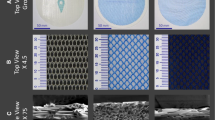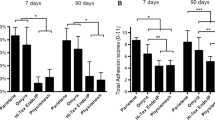Abstract
Background:
New materials have been devised to prevent postoperative adhesions when placing a prosthesis in contact with abdominal contents.
Methods:
Eighty rats underwent laparotomy and denudation of the serosa of the cecum and peritoneal covering of the abdominal wall. Five treated mesh products (Parietex Composite, Parietene Composite, Bard Composix E/X, Sepramesh, and Gore-Tex Dual Mesh) and one untreated mesh product (untreated Parietene) were randomly placed between the cecum and abdominal wall. A group without mesh was used as control. The animals were sacrificed at 21 days following surgery and analyzed for the presence of adhesions.
Results:
The incidence of adhesion formation, mean adhesion area, maximum adhesion length, and strength of adhesion separation were similar between Parietex Composite, Parietene Composite, and Bard Composix E/X, and they were significantly less than with Sepramesh, untreated Parietene, and the control group. Gore-Tex Dual Mesh resulted in less adhesions, adhesion area, mean strength of separation, and work of separation than the untreated Parietene group and the control group. Sepramesh resulted in less strength and work of separation compared to the control group.
Conclusions:
The incidence of adhesions and work and strength of adhesion separation are reduced when using a treated mesh, compared to the untreated mesh and the control group without mesh. Parietex Composite, Parietene Composite, Bard Composix E/X, and Gore-Tex Dual Mesh were superior to Sepramesh, untreated Parietene, and the control group in the prevention of adhesion formation.
Similar content being viewed by others
References
Luijendijk RW, Hop WCJ, van der Tol MP, de Lange DC, Braaksma MM, Uzermans JN, Boelhouwer Ru, de Vires BC, Salu MK, Wereldsma JC, Bruijnincky CM, Jeekel J (2000) A comparison of suture repair with mesh repair for incisional hernia. N Engl J Med 343:392–398
Morris-Stiff GJ, Hughes LE (1998) The outcomes of nonabsorbable mesh placed within the abdominal cavity. Literature review and clinical experience. J Am Coll Surg 186:352–367
Deguzman LJ, Nyhus LM, Yared G, Schlesinger PK (1995) Colocutaneous fistula formation following polypropylene mesh placement for repair of a ventral hernia: diagnosis by colonoscopy. Endoscopy 27:257–261
Lamb JP, Vitale T. Kaminski DL (1983) Comparative evaluation of synthetic meshes used for abdominal wall replacement. Surgery 93:643–648
Menzies D (1993) Postoperative adhesions: Their treatment and relevance in clinical practice [review]. Ann R Coll Surg Engl 75:147–153
Ray NF, Larsen JW Jr, Stillman RJ, Jacobs RJ (1993) Economic impact of hospitalizations for lower abdominal adhesiolysis in the United States in 1988. Surg Gynecol Obstet 176:271–6
Pijlam BM, Dörr PJ, Brommer EJP, Vemer HM (1994) Prevention of adhesions (review) Eur J Obstet Gynecol Reprod Biol 53:155–163
Ellis H (1982) The causes and prevention of intestinal adhesions. Br J Surg 69:241–243
Luijendijk RW, de Lange DCD, Wauters CC, Hop WC, Duron JJ, Pailler JL, Camprodon BR, Holmdahl L, van Geldorp HJ, Jeekel J (1996) Foreign material in postoperative adhesions. Ann Surg 223:242–248
Risberg B (1997) Adhesions: Preventive strategies. Eur J Surg (Suppl) 577:32–39
Harris ES, Morgan RF, Rodeheaver GT (1995) Analysis of the kinetics of peritoneal adhesion formation in the rat and evaluation of potential anti-adhesive agents. Surgery 117:663–669
Bellón JM, García-Carranza A, Jurado F, García-Honduvilla N, Carrera-San Martín A, Buján J (2001) Peritoneal regeneration after implant of a composite prosthesis in the abdominal wall. World J Surg 25:147–152
Cristoforoni PM, Kim YB, Preys Z, Lay RY, Mortz FJ (1996) Adhesion formation after incisional hernia repair: A randomized porcine trial. Am Surg 62:935–938
Farmer L, Ayoub M, Warejcka D, Southerland S, Freeman A, Solis M (1998) Adhesion formation after intraperitoneal and extraperitoneal implantation of polypropylene mesh. Am Surg 64:144–146
Malazgirt Z, Ulusoy AN, Gok Y, Karagoz F, Tac K (2000) Bioabsorbable membrane prevents adhesions to polypropylene mesh in rats. Hernia 4:129–133
Burns JW, Skinner K, Colt J, Sheidlin A, Bronson R, Vaacobi Y, Goldberg EP (1995) Prevention of tissue injury and postsurgical adhesions by precoating tissues with hyaluronic acid solutions. J Surg Res 59:644–652
Eller R, Bukhari R, Poulos E, McIntire D, Jenevein E (1997) Intraperitoneal adhesions in laparoscopic and standard open herniorrhaphy. An experimental study. Surg Endosc 11:24–28
Garrard CL, Clements RH, Nanney L, Davidson JM, Richards WO (1999) Adhesion formation is reduced after laparoscopic surgery. Surg Endosc 13:10–13
Author information
Authors and Affiliations
Corresponding author
Additional information
Disclosure statement: This study was sponsored by: Sofradim, Trévoux, France
Rights and permissions
About this article
Cite this article
Gonzalez, R., Rodeheaver, G.T., Moody, D.L. et al. Resistance to adhesion formation: A comparative study of treated and untreated mesh products placed in the abdominal cavity. Hernia 8, 213–219 (2004). https://doi.org/10.1007/s10029-004-0213-x
Received:
Accepted:
Published:
Issue Date:
DOI: https://doi.org/10.1007/s10029-004-0213-x




